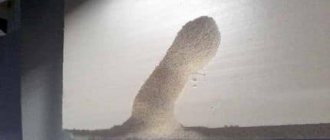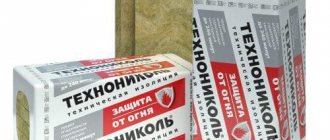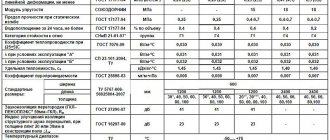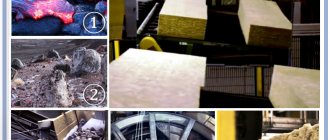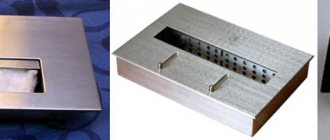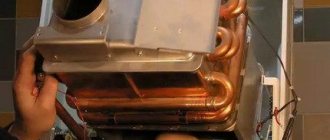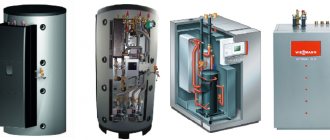| Place | Name | Characteristics in the rating |
| Top 10 best mineral wool manufacturers |
| 1 | ROCKWOOL | Best quality and practicality |
| 2 | KNAUF | Most popular company |
| 3 | ISOVER Saint-Gobain | The best combination of price and quality. Durability |
| 4 | IZOVOL | The highest level of fire safety |
| 5 | URSA | High-tech equipment |
| 6 | TECHNONICOL | Better rigidity. Withstands heavy loads |
| 7 | BELTEP | High wear resistance |
| 8 | PAROC | Practicality and reliability |
| 9 | Isoroc | Universal characteristics |
| 10 | Thermolife | Good sound insulation |
It is impossible to imagine the arrangement of any room without heat-insulating materials for walls and floors. Mineral wool is one of the most effective types of inorganic fiber insulation. Thanks to the air contained in its spaces, heat is retained. The product is made from glass or rocks. The best features help keep cold air out of your home. Therefore, today it is the most popular and durable product.
There are many manufacturers on the modern market that successfully and efficiently produce mineral wool, which is suitable for any geometry. Thanks to the flexibility of the material, builders create sealed seams. The insulation is quite fire-resistant, which allows you to be sure of safety. In addition, during operation it does not emit toxins. We invite you to familiarize yourself with the leading brands in this field to evaluate the experience of each of them.
Knauf produces everything!
Photo: www.dostavkasmesi.ru
Knauf is a manufacturer that has proven more than once that it can provide the construction market with the best offers. Thermal insulation is no exception. Knauf offers good quality mineral wool based on basalt fiber, as well as glass fiber composition. The first option is widely used for technical insulation, in construction and in the production of complex equipment. Fiberglass insulation is produced for specialized purposes (TEPLOKnauf), as evidenced by its names:
- HEATWALL;
- HEAT stove;
- WARM roofing;
- Acoustic partition;
- HEATROLL.
Most of the mineral wool sold by the manufacturer belongs to the Knauf Insulation series. There are no toxic phenol-formaldehyde resins used in the production of this product. The Knauf Insulation and TEPLOKnauf thermal insulation lines are intended for the construction of residential buildings by individuals and construction organizations.
Disadvantage : high price
Rating : 9.9 points out of 10
Reviews : “You rarely hear a bad word about Knauf. This means that the material is truly excellent.”
Production Features
It is worth noting that wool in the Russian Federation is produced from various raw materials - diabase, dolomite, basalt, slag. Externally, mineral wool from different manufacturing companies may not differ, but technologically it does. Formulas are calculated in specialized laboratories, the results of the research are a trade secret.
In general, the recipe looks like this:
- Stage 1. Melting of raw materials to a certain state. The prepared mixture is loaded into a specialized oven. The temperature reaches one and a half thousand degrees Celsius. The length and thickness of the fibers and their technical characteristics are determined from the degree of viscosity of the mass.
- Stage 2. The mass is placed in a centrifuge. Inside, rotating shafts roll the composition until discrete fibers are formed. A binding element is also poured here - a synthetic composition that holds the raw melt together. Next, a powerful air stream transfers the resulting mass into the cooling chamber.
- Stage 3. The lamella apparatus forms fibers of the required volume and length. Then treatment is applied in a heat chamber. When exposed to high temperatures, the mass polymerizes and reaches its final volume, size and shape. Strength indicators are formed at the final stage, where it is extremely important to maintain the correct temperature conditions.
- Stage 4. The final stage of production is the molding and packaging of the resulting mass into blocks of the required dimensions. The cotton wool is packed in shrink film. It allows you to preserve the properties of cotton wool during storage and transportation.
Rockwool is a world leader
Rockwool was founded in 1909 and is still headquartered in Denmark. For almost 110 years of its existence, the company has become a leader not only in the European, but also in the global thermal insulation market. It now has 28 factories in North America, Europe and Asia. In Russia there are three enterprises in the Moscow, Chelyabinsk and Leningrad regions. Another plant operates in Tatarstan. The total number of employees of the company reaches 10,000 people.
The product range contains materials for insulation and fire protection, as well as sound insulation in domestic and industrial premises, ships, and oil rigs. This company was the first in the world to be awarded the Eco Material Green environmental safety mark, so its products are very popular for insulating bedrooms and children's rooms.
Rockwool stone wool for private houses and apartments
For private housing construction, the manufacturer has a whole line of stone wool insulation. The most popular among them are insulation materials such as:
- LIGHT BUTTS
- SAUNA BUTTS
- ACOUSTIC BUTTS
LIGHT BATTS are lightweight mineral wool slabs designed for thermal insulation of non-load-bearing structures in the insulation system of a house or apartment. The thermal conductivity of this insulation is 0.036 W/(m K). It can be used to insulate a large number of objects: attic rooms (pitched roofs), partitions, joist floors, walls lined with siding, frame walls, balconies, baths, saunas
SAUNA BATTS are basalt slabs with a density of 40 kg/m3 and can be used both on the ceiling and on the walls. A special feature of the insulation is its one-sided coating with aluminum foil, which does not allow steam and water to pass through. This protects the fibers from getting wet and shrinking, and also completely blocks the escape of heat from the room. Using such cotton wool in a bath or sauna will ensure the preservation of temperature and the integrity of the partitions. In this case, installation of a vapor barrier is not required, which reduces construction costs. The material can withstand up to 200 degrees without loss of properties.
ACOUSTIC BATTS stone wool has a pronounced sound absorption effect, therefore it is optimal for insulating walls and ceilings in an apartment, which ensures comfort and increases fire safety. Suitable for all types of residential and non-residential premises, installation in suspended ceilings is permitted. The sound absorption index with a layer of 50 mm is 0.8 according to GOST 23499-2009. A thickness of 200 mm provides sound absorption class A with an index of 1.0. The density of such basalt slabs varies from 35 to 45 kg/m3.
Rockwool LIGHT BUTTS.
Rockwool stone wool for facades
Insulation of facades requires durable slabs that will interact well with subsequent finishing materials. For this purpose, Rockwool produces VENTI BATTS N OPTIMA, with the function of repelling water thanks to synthetic binders. The main material is fibers from basalt rocks, which provide high insulation and strength.
In terms of density, VENTI BATTS N OPTIMA stone wool has an indicator of 32 kg/m3 and is not prone to destruction under the influence of its own weight and emphasis on attachment points. Thermal conductivity is 0.036 W/(m*K). The material does not burn at all, which protects the building when trying to set fire to the facade. The thickness of the slabs varies from 50 to 200 mm and is selected according to insulation needs.
Rockwool VENTI BUTTS N OPTIMA.
Stone wool for roof insulation
Roof insulation must withstand the heavy weight of subsequent layers and precipitation, so increased demands are placed on them.
The manufacturer Rockwool has a wide range of products for roof insulation, both flat and complex shapes:
- ROOF BATTS N LAMELLA - as the name implies, it is produced in the form of lamellas or strips, which is convenient for installation on roofs of various shapes. Installation with dowels or glue is allowed. Produced only with a thickness of 200 mm. It has a high density of 115 kg/m3, so it can withstand up to 5500 kg of pressure per square meter.
- ROOF BATTS D OPTIMA - made with two layers (hard outer and regular), which increases strength and reduces weight. Thicknesses range from 60 to 200 mm. The hard layer is always 15 mm. The density of the outer side reaches 205 kg/m3, and the inner one 120 kg/m3.
- ROOF BATTS N OPTIMA - designed for organizing the lower layer of the roof with subsequent laying of more durable materials. The density is 100 kg/m3, and the thermal conductivity is 0.036 W/(m*K). Thickness ranges from 40 to 200 mm.
- ROOF BUTTS IN OPTIMA are especially durable slabs with a density of 160 kg/m3 (full thickness), intended for laying as the last layer before the main roofing material. The plates are hydrophobic and insulate not only from freezing temperatures, but also from moisture penetration.
- SANDWICH BUTTS K - designed for use as a middle layer in sandwich panels. They can be located immediately behind the metal shell. Rigidity allows you to withstand the pressure of atmospheric precipitation. Density is 140-155 kg/m3. Compression can withstand forces up to 10,000 kg/m2.
- ROOF BUTTS IN EXTRA - slabs are produced with a thickness of 40-50 mm and serve as the top layer in the construction of the roof. The density of the entire material is 190 kg/m3.
Rockwool ROOF BUTTS.
Kinds
There are three main types, namely:
- Glass wool. Sand, limestone, etiboron (mineral) and soda are involved in its creation. The creation technology is described above. The downside is that glass fiber is brittle and can withstand up to 450 degrees of thermal radiation.
- Stone wool. Melts from rocks at 1500 degrees.
- Slag wool . The raw material for creation is waste from the blast furnace industry. The creation technology is almost no different from the classical one.
Which one is better for the home and beyond, how to choose the right one
The selection should be made in accordance with the following criteria:
- purpose, whether the work will be performed in domestic conditions or at a professional level;
- which structural element will be insulated; the range of manufacturers includes universal and specialized options;
- density, the lower the density, the higher the ability to insulate;
- thickness determines the thermal conductivity coefficient;
- manufacturer, characteristics and cost depend on the brand.
Material calculation
Differences in the dimensions of mineral wool elements can mislead you. Professionals try to save working time. The price of a mistake is the same for everyone - budget overruns and loss of time.
To perform calculations, use an online calculator. It will take into account all the necessary quantities, parameters and conditions.
A small reminder on using the calculator:
- Please note that not all Russian settlements are represented in the list of cities. Therefore, try to choose options that are minimally distant from the location of your home. This is important because this parameter determines the average winter temperatures;
- all numerical values (thickness) are displayed in millimeters. Just in case: 1 m is 100 cm or 1000 mm;
- We recommend looking at the detailed characteristics of insulation on the manufacturers’ websites. There you will also find recommended prices for this type of product;
- All calculations are approximate, so it would not be superfluous to add 10% to the results obtained.
Having obtained the thickness of the thermal insulation as a result of calculations and knowing the area of the walls, it is easy to calculate the volume of insulation. We hope this is helpful.
Consumer choice
In private construction, approximately 80% of the purchased insulation is basalt and stone mineral wool, which have universal quality characteristics. Slag and fiberglass wool are used more often in enterprises for thermal insulation of specific objects.
Reliable thermal insulation
In practice, which mineral wool is best for insulation needs to be decided taking into account a specific building, room, structure. When making design decisions, specialists calculate in advance what density of mineral wool is best to choose and how to use the material correctly.
Errors most often occur not because of the quality of the insulation, but because of its improper use. It is recommended to carefully study information from the manufacturer about the characteristics and properties of mineral wool, and features of use.
Which is better polystyrene foam, basalt wool or mineral wool?
| Type of insulation | Advantages | Flaws |
| Expanded polystyrene | + moisture resistance + lightness + low price + good adhesion | — vapor tightness - breaks and crumbles easily - afraid of ultraviolet radiation |
| Basalt wool | + environmental friendliness + low thermal conductivity + fire safety + variety of packaging | - high price - rodents form nests - low moisture resistance |
| Mineral wool | + affordable price + rich assortment + versatility + fire resistance | - poor adhesion - hazardous to human health - caking |
Rating of the best mineral wool manufacturers
| Nomination | place | Name of product | rating |
| The best mineral wool manufacturers in terms of price-quality ratio | 1 | ROCKWOOL | 4.9 |
| 2 | Knauf | 4.8 | |
| 3 | Isover | 4.7 | |
| 4 | Paroc | 4.7 | |
| 5 | Ursa | 4.7 | |
| 6 | IZOVOL | 4.6 | |
| The best manufacturers of inexpensive mineral wool | 1 | Beltep | 4.7 |
| 2 | TechnoNIKOL Rocklight | 4.6 |
Installation instructions
Installation of glass wool is quite simple.
- A frame made of timber with a cross-section of no more than 3x5 cm is mounted on the insulated surface.
- The unpacked material is cut with a construction knife, pressed down and placed in the sheathing. If there are joints, they must be filled with foam or covered with reinforcing tape.
- Additional fastening elements are not required, since the material, when straightened, serves as a spacer for itself.
- Covered with vapor barrier film.
- When working with glass wool, special attention should be paid to protecting exposed areas of the body.
Popular floor insulation schemes
In practice, most often, two schemes for insulating the floor of the basement/lower floor are used. The first is the most reinforced, when the insulation is present both under the joists and between them. Such thermal insulation, as described in the first case, is used only in northern latitudes, where the ground freezes quite noticeably in winter.
But most often, on the first floor of a building, logs are mounted on top of the screed, and in some cases, on top of well-planned soil.
Let's look at both examples suitable for the basement floor, and then we'll talk about insulating the floors of the upper rooms.
The diagram provides options for floor insulation for the lower floors. The DSP layer can be simplified, which is what most owners prefer to do
Reinforced thermal insulation option
According to this scheme, first, even before installing the logs, it is necessary to level the soil and insulate it with the bottom layer.
As insulation for the first layer, builders can choose:
- expanded clay concrete;
- planned layer of expanded clay;
- extruded polystyrene foam;
- a hard and denser type of penoplex.
Logs are already installed on top of it, after which the space between them is also carefully filled with insulation. This time it can be the same penoplex or one of the varieties of cotton wool.
In this case, people often resort to double waterproofing - one is laid between the upper and lower layers of insulation, the other is placed on top of the upper one, on which the counter-battens for ventilation and, directly, the floorboards will be attached.
In this option, penoplex was chosen as the bottom layer of insulation. The material of the top layer does not have to be identical to the bottom
Conventional insulation scheme
Everything is clear here. The logs are mounted directly on top of the leveled ground surface or, in the case of a screed, on it.
Next, a layer of insulation is laid on them. On top of the insulation is a layer of vapor barrier, which, as a rule, is an ordinary thick polyethylene film. Then thin counter-battens are nailed on top of the joists (some may neglect them), after which the final flooring is laid.
If you need to insulate the floor on the upper floors, then you will have to act a little differently. Here, a layer of vapor barrier is first laid on the ceiling material - the same film, then only the logs are installed.
Often in this case, builders lay a kind of subfloor on top of the ground - the basis for the insulation. This is what it will look like on the diagram
When insulating the floor with mineral wool or ecowool, a lower layer of vapor barrier must be present. This is especially true for the second and all subsequent floors.
The space between the joists is sealed with insulation, after which everything is covered again with film. Counter battens are screwed onto the joists with a screwdriver, onto which the finished floor is laid.
We also recommend reading the article where we described in detail how to put wood floor insulation into practice.
